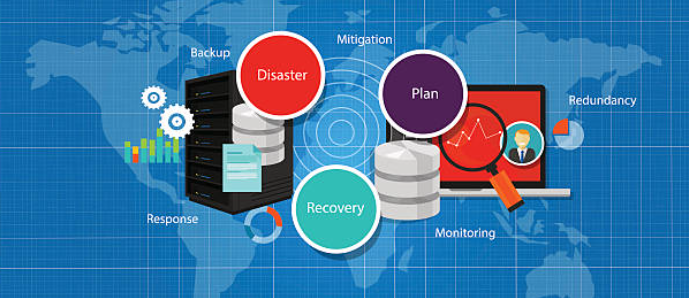Five ways to prepare for your business continuity plan
Have you ever thought about how to prepare your business continuity plan? If not, you should definitely try it! It’s really important to think about different scenarios of unexpected situations at work and how to deal with them effectively. Read this article to find out 5 ways on how to prepare for your business continuity plan.

Build a Business Continuity Team
You know that fire you’re supposed to have in place? Yep, it’s also useful during an emergency. Business Continuity (BC) is like insurance; your hope is that you never need it, but if something bad happens, BC can save you. And building a BC team is essential to creating a solid BC plan; putting together an awesome team requires expertise and dedication—no two people will be able to tackle all of these tasks on their own. Take time to think about who could serve as a potential teammate. Maybe it’s someone from IT or Facilities, or perhaps you want to cross-train other teams so that they can take responsibility during high-stress situations. Either way, make sure everyone knows what his or her role will be in case disaster strikes. Additionally, consider how prepared each person needs to be: If their role involves ensuring supplies get distributed quickly and efficiently, they may need more than just hands-on experience. Be sure to set guidelines for preparation and ongoing training based on each individual’s responsibilities so that expectations are clear.
Conduct Preliminary Risk Assessments
 Conducting a preliminary risk assessment helps you determine what kinds of risks exist within your business and whether you need to take steps to mitigate them. If you’re not sure where to start, look at insurance providers or organizations that provide guidance about these kinds of issues. And don’t forget: if you have employees, labor laws might impose certain obligations on you when it comes to workplace safety. The Department of Labor offers some great resources in its Employer’s Guide to Workplace Safety and Health. It includes information on topics like constructing safe workplaces, protecting against injuries in existing buildings and general industry compliance guidelines (and how they apply specifically to your business). Keep an eye out for specific regulations relating to your industry; in many cases, compliance is mandatory. When in doubt, consult with a legal professional specializing in employment law. One potential pitfall? Poor safety practices can put a real damper on work relationships—meaning increased attrition could impact your bottom line down the road.
Conducting a preliminary risk assessment helps you determine what kinds of risks exist within your business and whether you need to take steps to mitigate them. If you’re not sure where to start, look at insurance providers or organizations that provide guidance about these kinds of issues. And don’t forget: if you have employees, labor laws might impose certain obligations on you when it comes to workplace safety. The Department of Labor offers some great resources in its Employer’s Guide to Workplace Safety and Health. It includes information on topics like constructing safe workplaces, protecting against injuries in existing buildings and general industry compliance guidelines (and how they apply specifically to your business). Keep an eye out for specific regulations relating to your industry; in many cases, compliance is mandatory. When in doubt, consult with a legal professional specializing in employment law. One potential pitfall? Poor safety practices can put a real damper on work relationships—meaning increased attrition could impact your bottom line down the road.
Create Key Event Scenarios
 The best-laid plans won’t be effective if they don’t have proper support and resources. Before you even think about putting pen to paper, make sure you have a solid support network in place. From a financial perspective, you should be able to afford an emergency fund that would carry you at least 3-6 months. From a human perspective, ask yourself whether or not you have people in your life who will help out during tough times. Are there people who you can turn to when things aren’t going as expected? This is an important consideration because it could determine whether or not your plan is put into effect; especially if it’s an extended problem of many months. If you do not have these types of relationships in place, consider speaking with someone like a therapist or licensed counsellor who might be able to help you create them. Also consider asking friends, family members, mentors—anyone whom you feel comfortable reaching out—if they are willing to get involved with your business idea/plan from various stages throughout development.
The best-laid plans won’t be effective if they don’t have proper support and resources. Before you even think about putting pen to paper, make sure you have a solid support network in place. From a financial perspective, you should be able to afford an emergency fund that would carry you at least 3-6 months. From a human perspective, ask yourself whether or not you have people in your life who will help out during tough times. Are there people who you can turn to when things aren’t going as expected? This is an important consideration because it could determine whether or not your plan is put into effect; especially if it’s an extended problem of many months. If you do not have these types of relationships in place, consider speaking with someone like a therapist or licensed counsellor who might be able to help you create them. Also consider asking friends, family members, mentors—anyone whom you feel comfortable reaching out—if they are willing to get involved with your business idea/plan from various stages throughout development.
Gather Resources and Support
 Make sure you have all of your data—documents, records, and hard drives—securely backed up. Also, line up any resources you might need in case of a disaster: temporary office space, IT support, phone service. Finally, identify external contractors who can help if there’s an emergency (such as fire or flood). Use word-of-mouth referrals or ask around at networking events; most businesses will be happy to help another local company out. If they can do it themselves, even better! But make sure you give them adequate warning so they don’t get caught off guard. Ask them how much notice they would need and when is their next available opening. Schedule accordingly. Having a vendor relationship like that is one way to ensure your continuity planning doesn’t fail during times of crisis. Remember to follow up with contacts periodically, too. You never know when something small could lead to huge benefits down the road!
Make sure you have all of your data—documents, records, and hard drives—securely backed up. Also, line up any resources you might need in case of a disaster: temporary office space, IT support, phone service. Finally, identify external contractors who can help if there’s an emergency (such as fire or flood). Use word-of-mouth referrals or ask around at networking events; most businesses will be happy to help another local company out. If they can do it themselves, even better! But make sure you give them adequate warning so they don’t get caught off guard. Ask them how much notice they would need and when is their next available opening. Schedule accordingly. Having a vendor relationship like that is one way to ensure your continuity planning doesn’t fail during times of crisis. Remember to follow up with contacts periodically, too. You never know when something small could lead to huge benefits down the road!
You also need to research places where you could store backup data offsite. For example, perhaps you want stored online (in case your building suffers water damage) but close enough by should something happen to its physical location too. Backup options can include storing at a local facility or even at someone’s house if they have space. Just be sure that those people have been vetted and can handle confidential information appropriately as well as not experience downtime during a disaster. If you don’t have time to do all of these steps on your own, there are resources available—including setting up a recovery plan with an established company. Doing so usually involves paying a fee upfront but might provide peace of mind knowing everything is being done according to strict standards and being monitored regularly.
Prepare for Potential Business Outages
Business continuity planning should address all potential emergency scenarios and should include: How to safeguard crucial documents and other information; Where alternate meeting spaces are located; Who employees can contact in case of an emergency; and What steps should be taken if an outage occurs. Once you’ve made a list of possible disasters that could affect your operations, prioritize them based on their likelihood and impact. Those that top your list should get more attention than those further down—and all need at least some level of preparation. Not sure where to start? We suggest taking a look at these resources from Leapfrog Market Team. It’s also a good idea to consult with insurance companies before devising a plan—they may have valuable insights into what perils you’re likely to face. And while we’re talking about insurance, don’t forget to take care of yourself too! The Small Business Administration has advice for businesses looking to protect themselves against catastrophic events such as terrorism or natural disasters. Don’t forget that there’s often value in investing even just a little bit in disaster prevention—putting systems in place now will save you lots of time and money down the road. Learn how to keep your business data safe: But protecting data isn’t enough. You also need to know how long it takes for different kinds of data recovery methods and explain why each recovery type is best suited for different situations.
Here’s our cheat sheet: Data recovery method Data recovery time Tape 10 days – 3 months Disk 2 – 5 weeks Hardware 1 – 2 weeks Software 30 minutes – several hours, depends on workload Faulty Memory Card Less than 12 months RAID arrays Days – Several Weeks Filesystem corruption A day or two Note that even files that appear completely erased can sometimes be recovered using simple software tools. Also, tape backup archives should never be disposed of until they’ve been written over 35 times (at least); otherwise they might not stay secure. For a full account of these factors, check out Wikipedia’s write-up on SCSI termination. Remember that backing up critical data reduces downtime but doesn’t eliminate it—even high-quality backups aren’t 100% reliable. Nevertheless, having such backups will help you sleep easy when your network goes down and helps to minimize damage caused by human error as well as hardware failures. Check out our post on Backups for more info.







